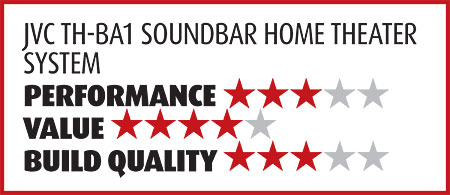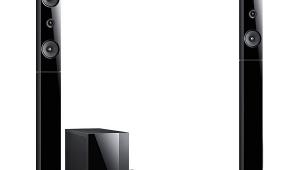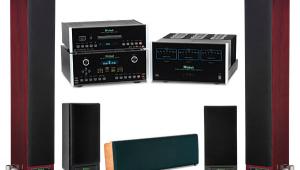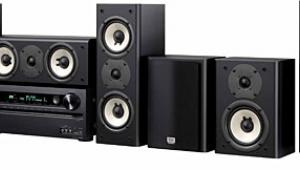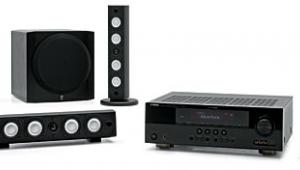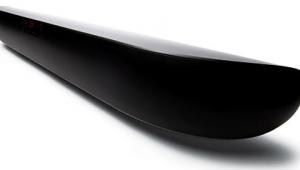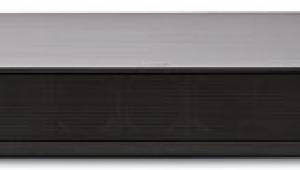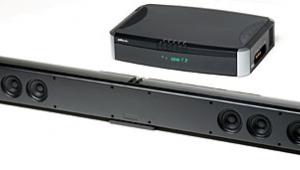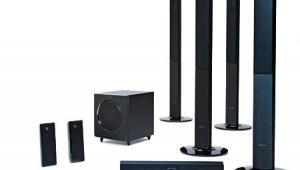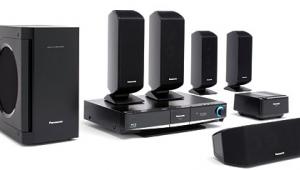JVC TH-BA1 Soundbar Home Theater System Page 2
When I watched movies, the surround channels didn’t accomplish much in the way of envelopment. I used the remote to raise and lower them, which only added a little fullness to the overall tonal balance. With ordinary movie content, the TH-BA1 soundbar didn’t seem to project surround effects anywhere near the seating area, or even in the center of the room, as some virtual surround systems do. Later, I ran test tones through the system to confirm my impressions.
Better in Stereo
But not before I ran the music demos. The soundbar and wireless sub performed more pleasingly with music than they did with movies. The system may not have realized the full potential of audiophile-grade material like Sony Classics’ new release of Mendelssohn Piano Trios. In fact, the better the material, the more I noticed the TH-BA1’s plastic-enclosure coloration. Still, Yo-Yo Ma’s cello and Emanuel Ax’s piano blended in the soundbar and sub without being unduly mangled, and Itzhak Perlman’s violin didn’t screech. I had the option to run the CD in its original stereo or with the Dolby Pro Logic II Music mode. The soundstage, especially the cello, was more solid in stereo. When I switched to DPLII, the mix was more diffused, but it didn’t have much more fullness.
With Heroes: A Yep Roc Records Sampler, the system showed a rudimentary ability to evoke a rhythm section within the limits of the sub’s 6-inch driver, modest amplifier, and small enclosure. Drums were OK, and basses were recognizable, if not perfectly pitched or balanced. High frequencies were limited, and the midrange development was modest, even within the limits of what are probably Pro Tools mixes. Still, the soundbar and sub lived up to their price point and then some.
Kenny Burrell’s For Charlie Christian and Benny Goodman is a tribute that’s recorded largely with guitar, bass, drums, and some occasional sax. The pristine mid-’60s recording—produced by Creed Taylor and engineered by Rudy Van Gelder—came through surprisingly well. Ron Carter’s bass was a treat, and Burrell’s electric guitar flowed warmly and gratifyingly.
In addition to the formal disc demos, I used the TH-BA1 for several hours of TV watching. It performed well with voices (even without boosting the center channel control), and it wasn’t unduly painful with buzz saw SUV ads.
Impressions and Tones
As I mentioned before, this nominally 4.1-channel system accepts two- or 5.1-channel input signals. It outputs these signals through the soundbar’s four full-range drivers and the sub’s bass driver.
I wondered how this would work in practice, so I used the 5.1-channel check chapter of the Avia test DVD to check the soundbar’s output. The chapter rotates noise and a male voice through all 5.1 channels, with the voice identifying each channel in turn. I sat down on the floor in front of the speaker and listened to find out which drivers the tones activated.
As I expected, the signal moved from left to center to right with strong results. The soundbar’s two outer drivers produced the left and right channels, and its two inner drivers produced a phantom center image. When I say “phantom center,” I’m not criticizing the output quality. It’s just a term that describes a center channel that’s produced by sending the center channel signal to the left and right speakers. It sounded pretty solid in practice.
To output surround channels, the TH-BA1 drives its inner drivers with out-of-phase sound. Based on what I’d heard in my movie demos, I didn’t expect much. But when the test tones swung around to the surround channels, I got a surprise.
The hissing noise of the test materialized close to the seating area. Even better, I could clearly hear the male voice that accompanies each channel rotating from the front of the room into the surround-right and surround-left areas. Although the surround left/right steering wasn’t effective with the noise, it was quite discernible with the male voice. Apparently, the movie demos didn’t tell me everything I needed to know about the potential of the speaker’s surround prowess.
The key thing about a modestly priced soundbar is how it compares with the speakers in your TV. Compared with the speakers built into my Sharp LC-32D4U, the JVC TH-BA1 was a minor but discernible improvement, especially in terms of bass.
However, today’s ultra-thin, smallbezel TV designs often have much paltrier speakers than my four-year-old Sharp, which has large speaker grilles on both sides of the screen. In many fancy new TV designs, the speakers don’t even fire straight at the listener. In that context, the TH-BA1 would be a major improvement. If you’re constantly dissatisfied with TV audio, but you don’t want to install an A/V receiver in every room, this product is an affordable and viable alternative.
